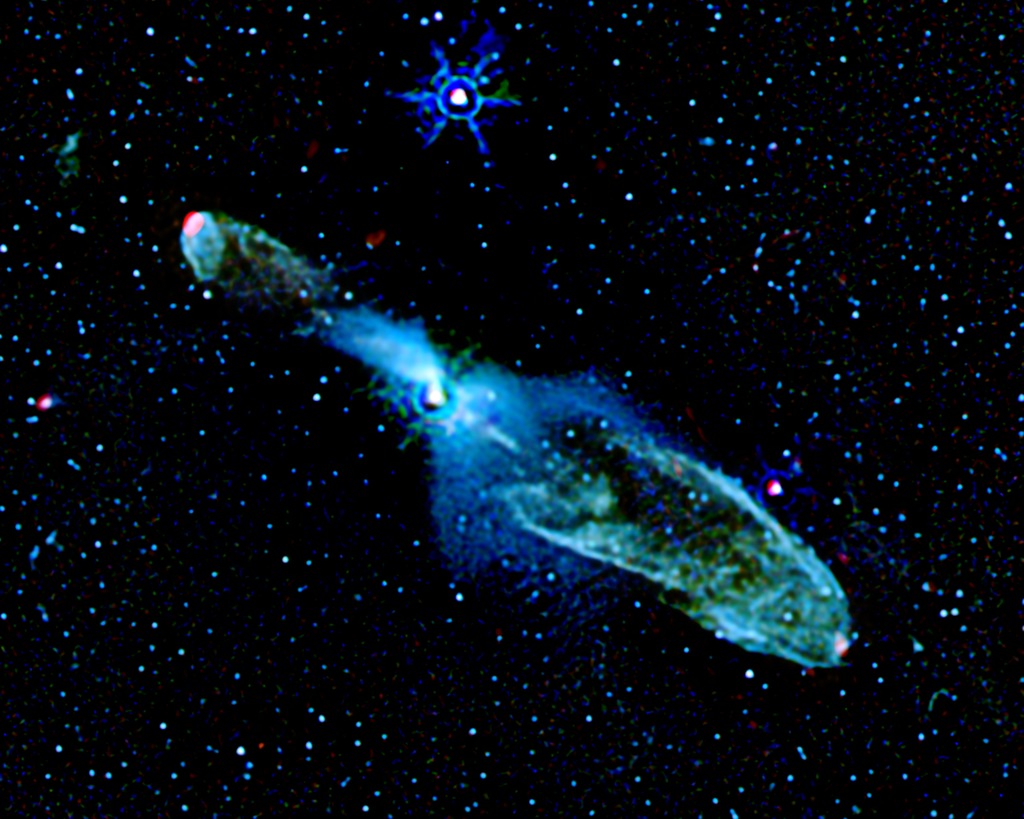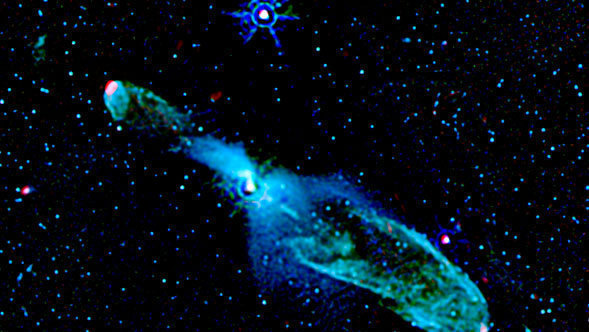
Credit: NASA/JPL-Caltech/T. Velusamy (JPL)
Observation • November 8th, 2007 • sig07-022
sig07-022
A new image from NASA's Spitzer Space Telescope shows a baby star 1,140 light-years away from Earth blowing two massive "bubbles." But instead of bubble gum, this youngster, called HH 46/47, is using powerful jets of gas to make bubbles in outer space.
The infant star can be seen as a white spot toward the center of the Spitzer image. The two bubbles are shown as hollow elliptical shells of bluish-green material extending from the star. Wisps of green in the image reveal warm molecular hydrogen gas, while the bluish tints are from starlight scattered by surrounding dust.
These bubbles formed when powerful jets of gas, traveling at 200 to 300 kilometers per second, or about 120 to 190 miles per second, smashed into the cosmic cloud of gas and dust that surrounds HH 46/47. Red specks at the end of each bubble show the presence of hot sulfur and iron gas where the star's narrow jets are currently crashing head-on into the cosmic cloud's gas and dust material.
According to Dr. Thangasamy Velusamy of NASA's Jet Propulsion Laboratory in Pasadena, Calif., baby stars and their potential planet-forming disks grow by gravitationally pulling in and absorbing surrounding gas and dust. Scientists suspect that these disks stop growing when the central baby star develops powerful winds and jets that blow away surrounding material.
"Spitzer can image these jets and winds in infrared light and help us understand the details of these phenomena," says Velusamy.
For astronomers who know what to look for, Spitzer's supersensitive infrared instruments are excellent tools for studying young stars embedded within thick clouds of cosmic dust and gas, revealing information about their growth.
About the Object
- Name
- HH 46/47
- Type
- Star > Evolutionary Stage > Protostar
- Nebula > Type > Star Formation
- Star > Evolutionary Stage > Young Stellar Object
- Star > Circumstellar Material > Outflow
- Distance
- 1,140 Light Years
Color Mapping
| Band | Wavelength | Telescope |
| Infrared | 3.6 µm | Spitzer IRAC |
| Infrared | 4.5 µm | Spitzer IRAC |
| Infrared | 5.8 µm | Spitzer IRAC |
| Infrared | 24.0 µm | Spitzer MIPS |
Astrometrics
- Position (J2000)
- RA =8h 25m 41.7s
- Dec = -51° 0' 39.5"
- Field of View
- 4.4 x 3.5 arcminutes
- Orientation
- North is 0.6° left of vertical





